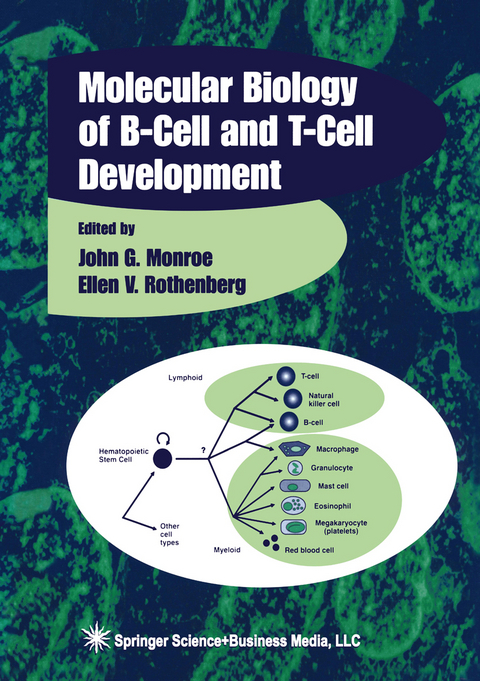
Molecular Biology of B-Cell and T-Cell Development
Humana Press Inc. (Verlag)
978-0-89603-536-2 (ISBN)
Despite the tremendous diversity of the cells of the hematopoietic system, they are all derived from common precursor cells that are generated in the fetus and persist into adult life. In this regard, Band T lymphocytes, which comprise the two arms of the antigen-specific and inducible immune system, though functionally very different, are descendants of the same stem cell precursor. In the past several years, we have witnessed an explosion of information regarding the process by which differentiation of B-and T-cells from stem cells occurs. This information, like the answers to most important biological questions, has come from multiple and diverse directions. Because all hematopoietic cells arise from common precursors, complex regulatory processes must be involved in determining commitment to various lineages. Understanding commitment to the B- or T-cell lineage remains incomplete; however, identification of transcription factors necessary for progression along specific B-and T-cell pathways suggests that we are on the verge of understanding the molecules involved in the initial fate-determining steps. Studies of this type previously could be accomplished only in nonmammalian systems that are more amenable to genetic approaches. However, new technologies allow increasingly elegant and informative studies in mammalian systems, particularly for cells of the hematopoietic system.
I: Stem Cells and Lineage Commitment Models.- CH. 1. Developmental Origins of Hematopoietic Stem Cells.- CH. 2. Self-Renewal of Stem Cells: The Intrinsic Timetable Model.- CH. 3. Transcription Factors Regulating Early Hematopoietic Development and Lineage Commitment.- II: Intrinsic Factors Regulating B and T Lymphopoiesis.- CH. 4. The Ikaros Gene Family in Hemopoietic Differentiation.- CH. 5. Transcriptional Control of B-Cell Differentiation by EBF and E2A.- CH. 6. Role of the Transcription Factor BSAP (Pax-5) in B-Cell Development.- CH. 7. The Role of PU.1 in the Regulation of Lymphoid and Myeloid Hematopoietic Progenitors.- CH. 8. Chromatin Structure and Lineage Determination.- III: Extrinsic Factors Regulating B and T Lymphopoiesis.- CH. 9. The Role of Cytokines in Hematolymphoid Development.- CH. 10. Life/Death Decisions in B-Lymphocyte Precursors: A Role for Cytokines, Cell Interaction Molecules, and Hormones.- CH. 11. Regulation of Lymphocyte Development by Microenvironmental and Systemic Factors.- CH. 12. Cytokines and Chemokines in 1-Cell Development.- CH. 13. Cytokine and Stromal Influences on Early B-Cell Development.- IV: Commitment and Ordered Progression in Development of Lymphoid Lineages.- CH. 14. Staging B-Cell Development and the Role of Ig Gene Arrangement in B-Lineage Progression.- CH. 15. Lineage Relationships Between B Lymphocytes and Macrophages.- CH. 16. TCR-Independent Development of Pluripotent 1-Cell Precursors.- CH. 17. T-Cell Development from Hematopoietic Stem Cells.- CH. 18. Gene Regulation in T-Cell Lineage Committment.- CH. 19. The ??/?? Lineage Decision: An Evaluation of the “T-Cell Receptor Determinant,” “Progenitor Precommitment,” or “Codeterminant” Models.- V: Selection Processes Operating During B-LymphocyteDevelopment.- CH. 20. Structure and Function of the Pro- and Pre-B-Cell Receptors on B-Lymphoid Lineage Precursor Cells.- CH. 21. Molecular Mechanisms Regulating Negative Selection in Immature-Stage B-Cells.- VI: Selection Processes Operating During T-Lymphocyte Development.- CH.22. How Essential Is the Pre-T Cell Receptor?.- CH.23. Developmental Stage-Specific Responses to Ligation of CD3-Containing Complexes.- CH.24. The Molecular Basis of Thymocyte Positive Selection and CD4/CD8 Lineage Commitment.- VII: Clinical Applications of Hematolymphoid Development.- CH. 25. Stem Cell Transplants for Hematopoietic Malignancies.- CH. 26. Placental Blood: Immunology, Transplantation, and Gene Therapy.- CH. 27. Human Hematopoietic Stem Cells, Progenitors, and Peripheral Blood Lymphocytes as Targets for the Correction of Immune System Disorders via Gene Therapy.
| Erscheint lt. Verlag | 1.5.1998 |
|---|---|
| Reihe/Serie | Contemporary Immunology |
| Zusatzinfo | 63 Illustrations, black and white; XIV, 587 p. 63 illus. |
| Verlagsort | Totowa, NJ |
| Sprache | englisch |
| Maße | 170 x 250 mm |
| Themenwelt | Studium ► Querschnittsbereiche ► Infektiologie / Immunologie |
| Naturwissenschaften ► Biologie ► Genetik / Molekularbiologie | |
| Naturwissenschaften ► Biologie ► Zellbiologie | |
| ISBN-10 | 0-89603-536-0 / 0896035360 |
| ISBN-13 | 978-0-89603-536-2 / 9780896035362 |
| Zustand | Neuware |
| Informationen gemäß Produktsicherheitsverordnung (GPSR) | |
| Haben Sie eine Frage zum Produkt? |
aus dem Bereich


